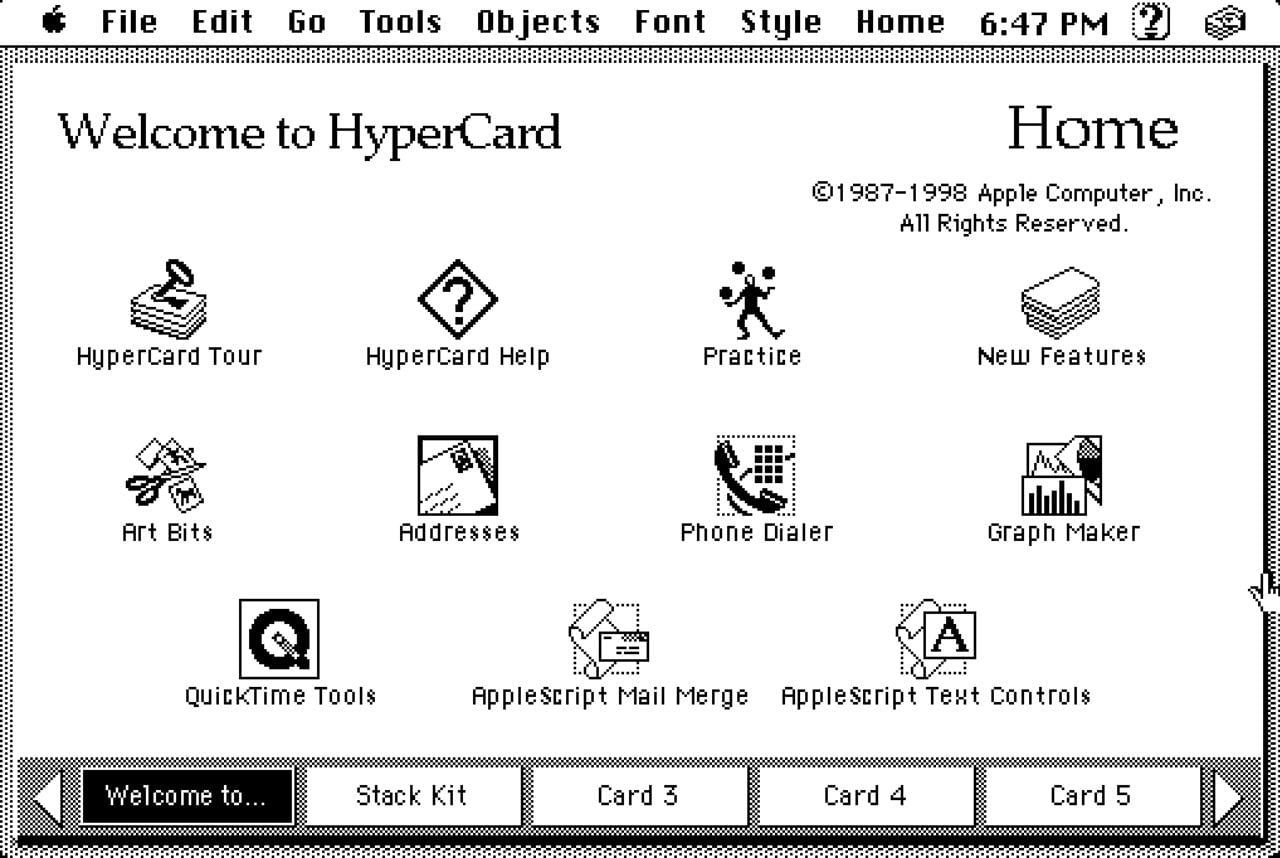
In the past two Retro Apple articles, I’ve highlighted hardware from Apple that made an impact on the tech industry as a whole: the Apple QuickTake 100 Digital Camera, and the Apple Newton MessagePad 2100. Today, I’ll talk about an Apple software product that changed the world and sadly no longer exists: HyperCard.
The Roots of HyperCard
HyperCard was a powerful, yet extremely easy to use tool for creating “stacks” — essentially flat-file databases that used hyperlinks as a way of navigating a stack of “cards”. You have to understand that at the time HyperCard was first released in 1987, there was no World Wide Web, so the concept of hyperlinks was completely new. HyperCard not only got a lot of Mac fans started in programming, but it also inspired some of the tools that we take for granted today.
HyperCard development began when Bill Atkinson, one of the key designers of the graphic user interface of the Mac, envisioned the system of linked cards during an LSD trip. He referred to the first version as WildCard, but as fellow Apple employee Dan Winkler began work on the HyperTalk scripting language that would let users assign actions to objects, the name was changed to HyperCard.
While the Apple product no longer exists except on pre-macOS Macs and collector Apple IIGS machines, its legacy lives on.

HyperCard existed as an Apple product for Mac and Apple IIGS until 2004. You could purchase it for $49.95, but most Mac owners got it for free as it was included with every new Mac. By the time HyperCard was dropped as a product, the need for such a tool had largely been replaced by the World Wide Web. Instead of standalone stacks, the Web linked people using internet browsers like Netscape or the dreadful Internet Explorer to web pages hosted on servers.
It’s fascinating to consider that the creator of the World Wide Web, Tim Berners-Lee, and the person behind hypertext transfer protocol (HTTP), Robert Cailliau, were both influenced by HyperCard. The creator of JavaScript, Brendan Eich, found the HyperTalk scripting language to be his inspiration. Even the Wiki concept (i.e., Wikipedia) found its roots in a HyperCard stack created by Wiki inventor Ward Cunningham. Are you familiar with AppleScript, the automation scripting language on the Mac? It is also based on HyperTalk. If you want a detailed look at how HyperTalk worked, here’s a link to a PDF of the HyperTalk 2.4 Reference stack courtesy of hypercard.org.

Why was HyperCard so incredible? It made it possible for just about anyone to create their own Mac programs. These programs were basically limited only by the imagination of “authors” (Apple didn’t use the term “developer” for HyperCard programmers). The original HyperTalk language was interpreted, so complex stacks could be slow in operation, but in 1989, Apple released HyperCard 2.0, which included an on-the-fly HyperTalk compiler for faster operation as well as a built-in debugger.
Apple really wanted everybody to be able to create their own programs, so everything about HyperCard was as non-threatening as possible. Programs were “stacks”, developers were “authors”, and HyperTalk was a “scripting language”. HyperTalk is considered a “high-level object-oriented scripting language”. What amazes me to this date is that this entire development environment originally came on just four double-sided floppy disks.
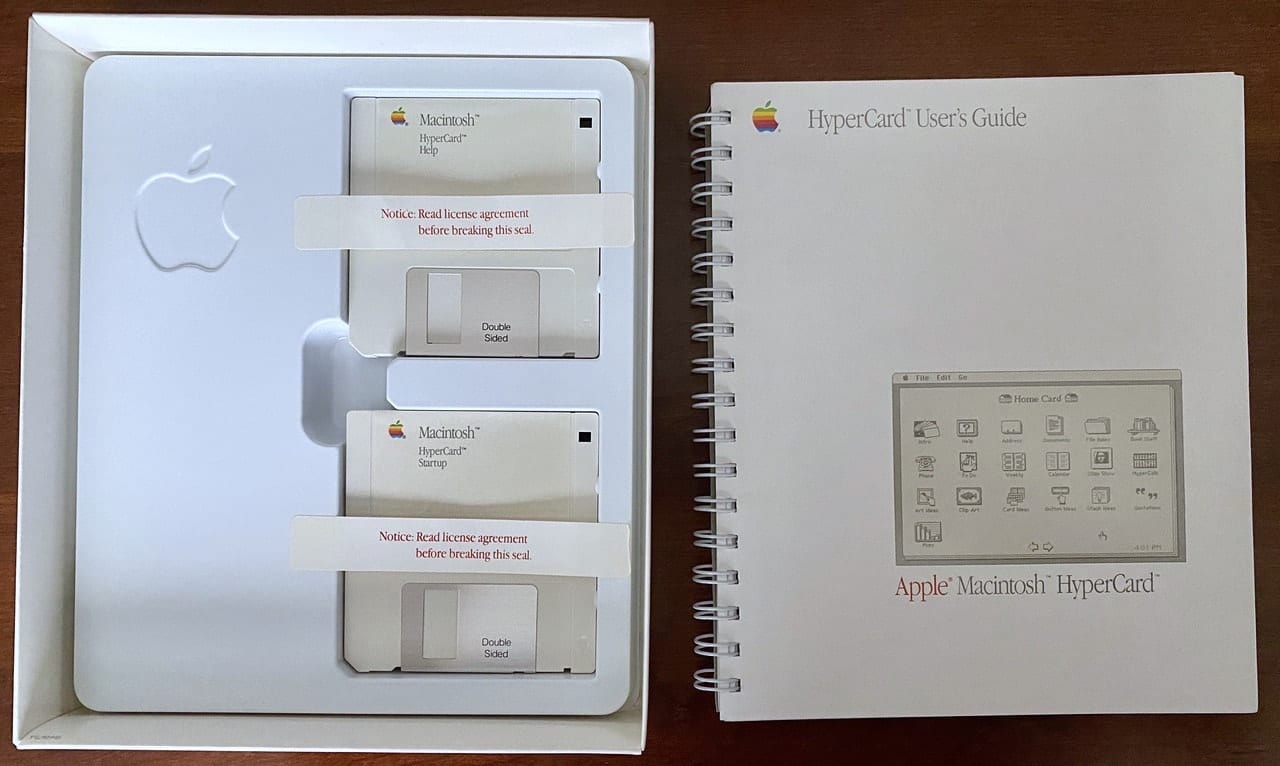
I was running a Mac-based IT department for a gas pipeline company when HyperCard was first demonstrated at the local Apple office, and the potential of the tool immediately grabbed my attention. Soon after the demonstration, Apple held a one-day seminar with author Danny Goodman at the local office. Goodman had written a book titled “The Complete HyperCard Handbook”, and all attendees not only had a chance to try out HyperCard but got a copy of the book for free. This book is considered to be the best-selling book ever for the Mac platform and was allegedly the fastest-selling computer book in history. Over 650,000 copies were sold, and I know that my copy of the first edition quickly wore out!
Goodman showed us how easy it was to create a stack by taking a blank “card”, adding fields and buttons to it, then writing scripts that reacted to mouse actions or acted on the data entered into a card. What could you use HyperCard and HyperTalk for? Everything and anything.
HyperMedia
One common example stack was an address book, but the app lent itself to doing much more. For example, let’s say you wanted to create an interactive textbook. You could create a stack that started with a title screen, then had a table of contents that — when clicked — sent you to a specific chapter or page. Each page could have graphics on it, or perhaps links that brought up a pop-up showing a definition of a word or term. This capability was called HyperMedia at the time, describing the use of links in a media presentation.
A lot of programmers immediately jumped on HyperCard as a tool for prototyping GUIs or creating working demos of full projects. It was so simple to bring up a blank card (screen), add buttons and fields, and then add actions that were either user-initiated (clicking on something) or that ran behind the scenes. For companies that needed self-running computer kiosks, HyperCard was perfect, as a HyperCard stack could be set to run automatically when a Mac booted up.
Don’t think that because HyperCard was easy to use that it wasn’t used by serious developers. The wildly popular 1990s game Myst was created using HyperCard.
Danny Goodman realized that the enormous success of his first book and HyperCard was begging for a follow-on, so he wrote the HyperCard Developer’s Guide. There’s still one copy available on Amazon if anyone is interested!

Inspired by Goodman, I started creating stacks both for my own use and for my company. To begin with, I created some training materials for new employees that used HyperCard’s capabilities to not only train the employees in safety regulations but test them as well.
HyperCard could be extended by the use of XCMDs (External Commands) and XFCNs (External Functions), which were created both by Apple and third-party developers. Our parent company at that time ran our company’s billing system on IBM mainframes, and I remember showing little interest in an XCMD I had heard about that provided mainframe connectivity.
That changed one day when I was working with our billing team and they were frustrated by the lack of progress from the mainframe programmers on a way to process some of the raw information that came in from gas metering sites around the state of Colorado into mailable bills. It occurred to me that I could use the mainframe connectivity XCMD to pull down a raw file from the mainframe, then use HyperScript’s powerful text handling features to parse the data into a .csv file format that could be imported into a Microsoft Excel spreadsheet. The spreadsheets could then be used for billing purposes.
The mainframe programmers balked at this, but when I had the system up and running within a week — when they were expecting it to take at least nine more months to get a mainframe solution working — they told me to go for it. While I won’t go into the details of HyperScript’s text handling, this Wikipedia article does a great job of explaining what was called “chunking” and the “chunk expressions” that made it possible. Oh, and by the way, it took the mainframe programmers more than three years to implement the same features I had running within a week. It’s not that they didn’t have the skill; they just didn’t prioritize our project.
The following video is from hypercard.org, and through a simple example, it shows the process of creating a stack, adding images, linking cards, and doing scripting. Many thanks to Uli Kusterer (@uliwitness) for letting me embed the video here.
HyperCard’s user interface was, for the most part, strictly monochrome. When HyperCard 2.2 appeared in 1992, it incorporated two commercial add-ons that allowed it to support color pictures and animations. Apple had no issues with competitors at that time, so other companies created HyperCard “clones” that boasted features that Apple didn’t add.
SuperCard
One of my favorite clones was SuperCard, which fully supported color and had a lot of power…but of course, it couldn’t really compete with the Web. Fortunately, it is still available from a company called Software Essentials and runs beautifully on macOS. The company provides a discount to anyone with old, original HyperCard materials (packaging, disks, and manuals), and SuperCard can translate old HyperCard stacks into its updated format. Perhaps it’s time for me to get back into SuperCard!
I’ve often thought that a modern-day HyperCard would be the perfect accompaniment to iPhones and iPads, allowing just about everyone to create their own apps without the need for Xcode and a Mac to do development work. Are you listening, Tim Cook?
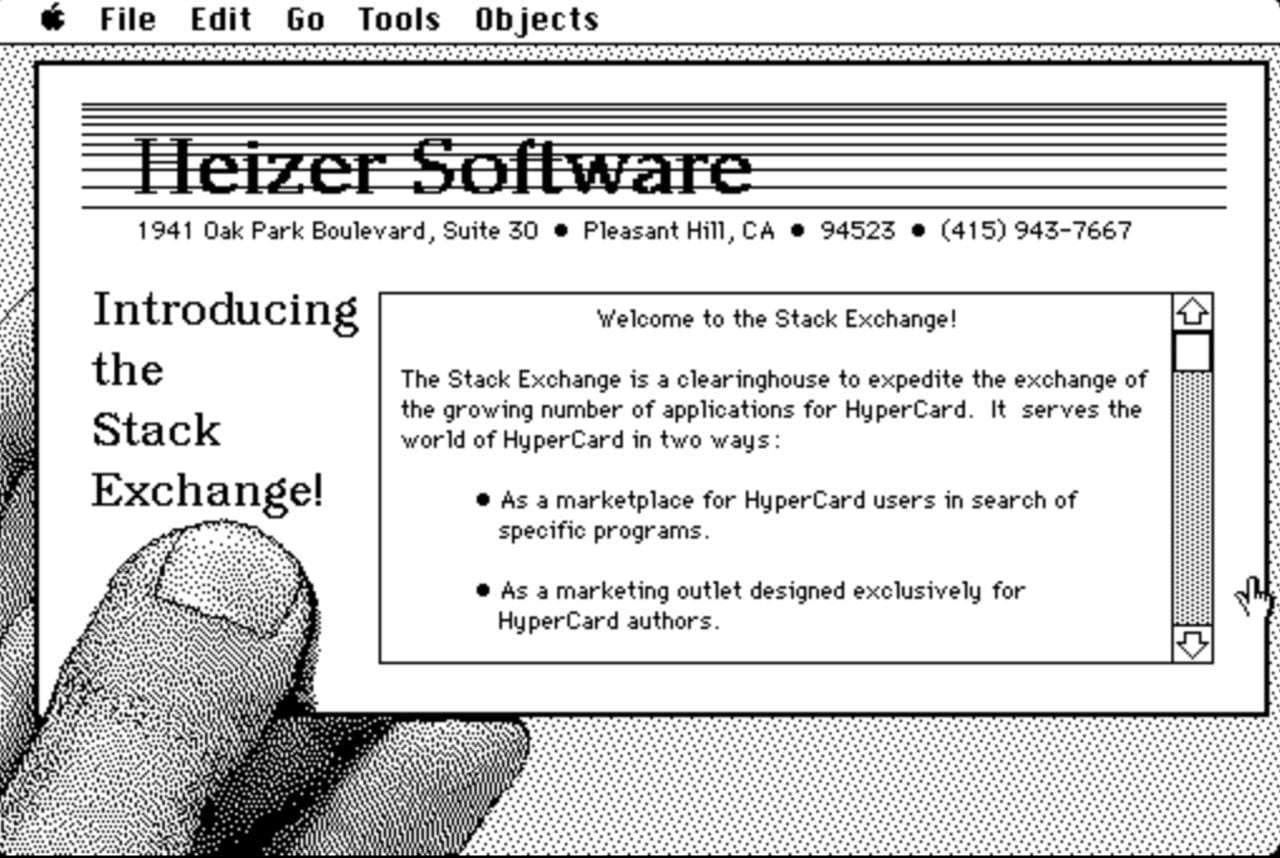
At one point, there was a thriving cottage industry of commercial stack authors, and I was one of them. Heizer Software ran what was called the “Stack Exchange”, a place for stack authors to sell their wares. Like Apple with the current app stores, Heizer took a cut of each sale to run the store, but authors could make a pretty good living from the sale of popular stacks. The company sent out printed catalogs with descriptions and screenshots of each stack; you’d order through snail mail, then receive floppies (CDs at a later date) with the stack(s) on them.
Try HyperCard on your Current Mac
Perhaps this long look down memory lane has given you the urge to go find a vintage Mac, load it up with System 7 or 8, then fire up a copy of HyperCard. Well, you don’t need to do that – there’s a wonderful emulator on the Internet Archive that runs in a web browser.
- To get a taste of this emulator, point your favorite browser to https://archive.org/details/AppleMacintoshSystem753 then click the green button on the “image”. An emulated Mac running System 7.5.3 – including HyperCard – launches, and you can play with the existing stacks or create your own. You can even run the emulator on your iPhone or iPad!
- If you have a bit more time, there’s also an emulator set up that includes 250MB of various HyperCard stacks from the Berkeley Mac User Group (BMUG). This will take some time to download and start up, so be patient.
Like the Newton MessagePad, which inspired today’s powerful and portable smartphones and tablets, and the QuickTake 100 (the first popular consumer digital camera), HyperCard went on to have an impact on that is still being felt to this day. When you fire up the Mac’s Automator app or work with Shortcuts on iPad or iPhone, you’re seeing a reflection of HyperCard’s capabilities. I hope that this article will inspire readers to not only take a look at HyperCard through the emulator but to try their hand with the modern-day tools to create their own workflows. They may not be as fun as the old HyperCard stacks, but they’re certainly more powerful.
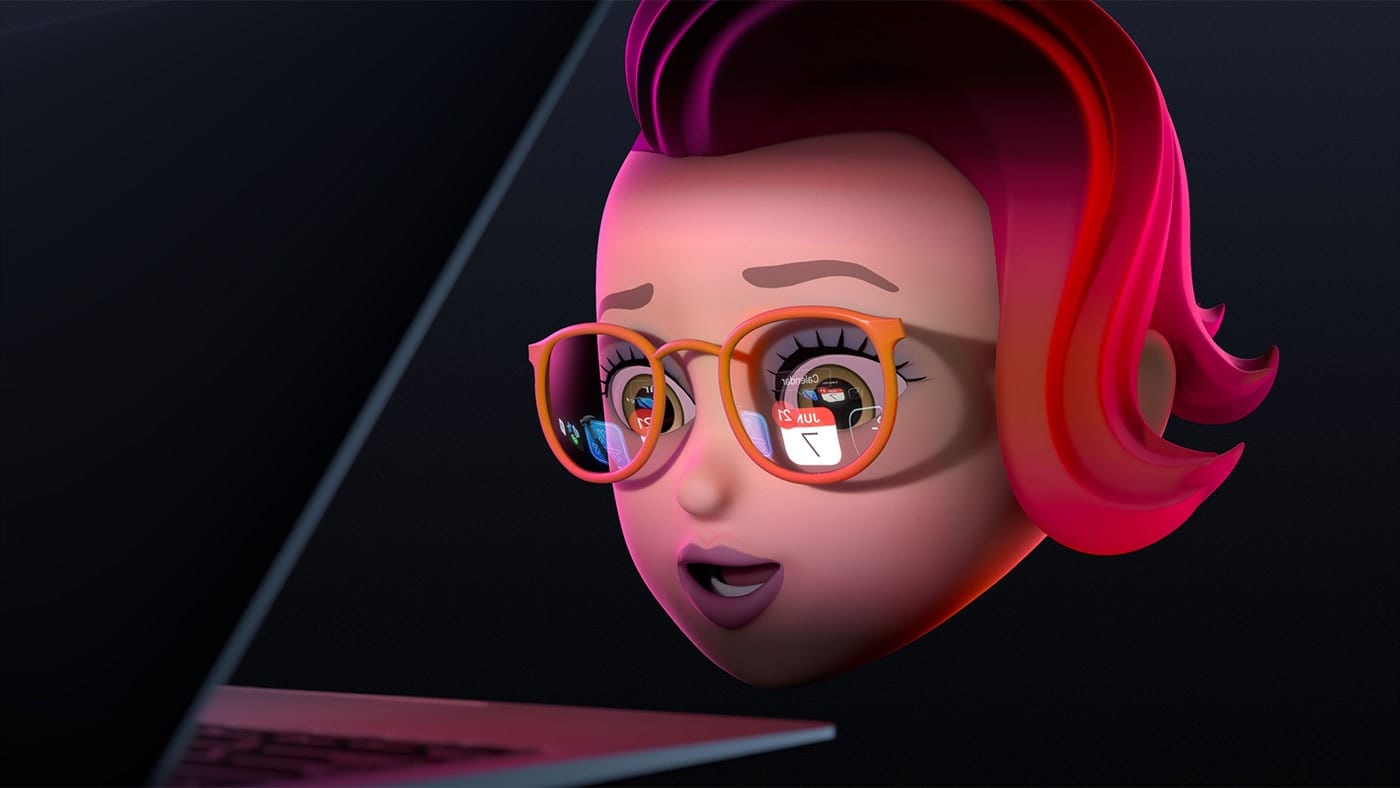

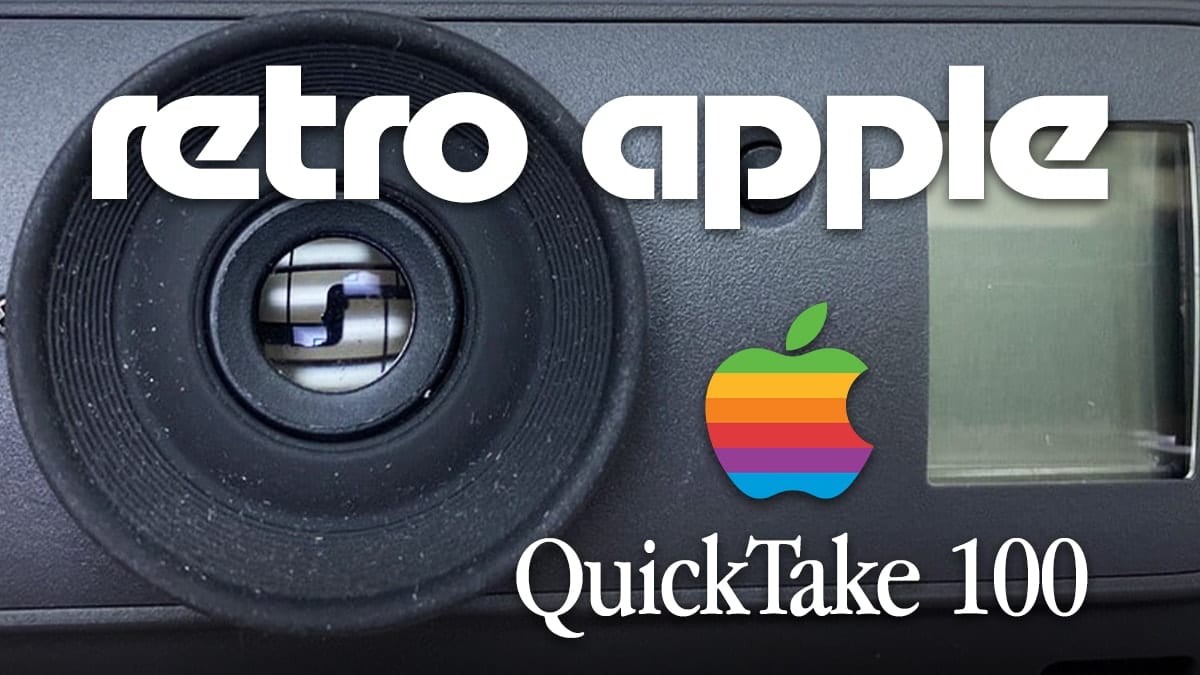
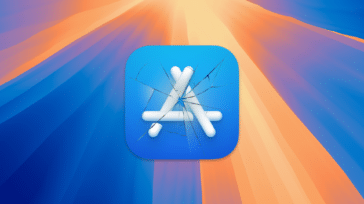
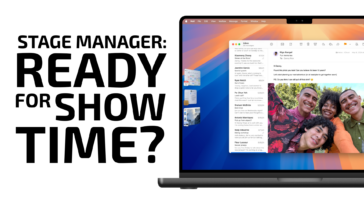




A sailor after my own heart.
I also remember when Hypercard came out. When I first started using it (I was just a simple hobby kinda guy), I thought what a powerful thing it was and how it would change the world.
I have been Apple and only Apple since 1981. I just wish that I had held on to all the Apple computers that I have bought over the decades.
Hypercard was outstandingly brilliant. I never understood why Apple, with all its capabilities did not nurture it, nor continue to develop it. It would be brilliant today as an App development paradigm … aside from its brilliance at enabling anyone do almost anything they can think of. A shame on Apple. And a shame on Supercard for dawdling on the move to 64 bit … how is that even a serious approach from any company?
I enjoyed your article very much, thank you, it brings back many memories.
I had a Mac plus back in 1989 and loved HyperCard. I had recorded my granddaughters voice, turned it into a resource and installed into my HyperCard stacks. Over the years the Mac broke, and new machines would not run HyperCard.
I am 73 years old now and a couple of months ago I found a Mac SE in a St Vincent DePaul thrift store. I am finally able to load and run my old 800k disks again. Kind of neat running the stacks with my granddaughters voice in them from over 30 years ago.
Life is good, just hope this old Mac keeps working for a few more years.
FYI, There is a spiritual successor to HyperCard (SuperCard,MetaCard, and less so AppleScript and ActionScript), it’s called LiveCode. If you miss the fun of building stuff with HyperCard, then you should download the GPL3 community edition at LiveCode.org and try it out, or get commercial license for the engine from LiveCode.com. It’s like HyperCard 9.6 with Apple let it die a slow death right around when Steve Jobs came back into the fold. Has Externals and it’s own slightly lower level sub-language (think CompileIt! FutureBasic and HyperTalk mix) called LiveCode Builder (LCB) for building GUI Widgets and Libraries for tapping into foreign code. And It’s cross platform, deploy web (CLI Server, and an HTML5 Engine port), mobile or desktop. I love it so much I’m building a Music / Input and GUI Kit for it. See my demo videos:
In about 1989 I used HYPERCARD and a MacSE to create a concordance to a hymnal. (A concordance is a dictionary of words appearing in a book, such as a Bible concordance.)
There were about 80,000 words in the hymnal, and about 8,000 individual words. I first wrote a script to create a card for each of the 8,000 words. Then a script to search the 80,000-word ASCII text file of the hymnal. The script searched the hymnal, word-by-word, and went to the card of each found word. It printed the line of the hymn, and the page number on the appropriate HyperCard.
For example, when the script got to “Amazing Grace, How Sweet the Sound,” it would first find the word “Amazing” and then find the card labeled “Amazing.” It would print the line of the hymn with the word, “Amazing grace, how sweet the sound” p. 288, Stanza 1, on the “Amazing” card. Then return to the main ASCII file to find the next word, “Grace”. Etc. etc.
I started executing the HyperCard script on an August Friday at quitting time, and then went on vacation until the following Monday week, about 10 days. The (16 mhz???) Mac SE was 90% through the process ten days later. Twenty-four hours after that it was complete, and I got a message on the screen, “Would you like to save?” Damn straight. Saved as a text file, and then exported the text file into v. 1 of “Pagemaker”. I was paid a few grand up front by the publisher for the camera-ready concordance.
The concordance is still in print and for sale, 30+ years later; and I still receive a tiny amount of royalty each year.
https://www.hopepublishing.com/W919-THE_WORSHIPING_CHURCH/
You have to scroll to the bottom to see the concordance.
I miss HyperCard.
I remember Hypercard and Stacks from a long time ago. My son and husband used it a bit – maybe more than a bit, but I never really had time to dip into it. I’m sure it’s still loaded on the right purple iMac and the 15+years-old Macs I still have. Like Randy Spydell, I would love to download these older machines to someone with a deeper appreciation of what they can do, because I really need the space here! PS – haven’t had anything but a Mac in the house since 1984. My hubby was a music and video producer, and ran his business – even billing – from MAcs.
Would any of those old emulators make it possible to view my old Voyager CDs?
If you mean the Voyager CD-ROMs, then possibly yes, with an installed System 7 emulator and the files copied from the CD-ROM to your hard drive. The emulator on the Internet Archive site won’t do it.
You would have to use something like SheepShaver with a OS 7.5 ROM, and probably have to do some HyperCard scripting to get the file path set to the correct folder.
The Voyager music programs (which I worked on) won’t work because the audio files are in a CD format not readable as computer data, so the audio has to play from the CD-ROM player’s audio output.
It is not only old software, but old equipment, no longer part of modern systems. These days I’m using LiveCode, a descendant of HyperCard, to create descendants of the Voyager music programs, currently something called “Music In the Air” with one of the original authors, Robert Winter. We plan to bring back some of our original work into a modern format.
I too was taken by HyperCard when it first came out and being ever a Mac evangelist since 1984, I wrote a published technical paper for The Society of Petroleum Engineers. I also gave this paper at one of SPE’s technical conferences. The stack showed multiple uses for HyperCard in the industry from finding people’s offices to drawing wellbore schematics. I gave a demonstration of HyperCard using my Mac Plus at the conference.
I also had a similar experience when my boss heard that I was programming to get my job done as an engineer. He said I was too highly paid to be programming and to let the IT Department do any programming I needed. So I gave a programming task to the IT people. A week past, so I ask how the programming was coming. They said they had not started programming yet, because first they had to write the manual. I went back to my office and had the program written in a couple of hours.
I learned to program with Hypercard, later continuing with Supercard. Love Supercard but now it is being phased out by Catalina. Does not leave any other option.
I took a little time to get there on my Mac using Safari. You might also try their commercial site (https://livecode.com/)
I loved HyperCard. I was into playing D & D at the time and, as a dungeon master, rolling up treasures could take a lot of time. I created a HyperCard stack that did just that. It even could generate a scroll with spells on it. Saved a lot of my time – all I had to do was enter the treasure type, click on the Go button, and in seconds poof there was the list.
I’ll have to check out SuperCard – sadly I don’t have the original HyperCard floppies. Those were the days.
This really takes me back. In the early 90s, I was commissioner of a Rotisserie Baseball league. Every week, I had to go buy a copy of USA Today and enter the players’ stats into a spreadsheet. Then I’d bring it into HyperCard and that’s where the magic happened. And it was like magic, watching the stats and standings update right before my very eyes!
A great little tool I only got to scratch the surface of.
I still have a 17-inch Powerbook running OSX 10.2.6 so I can run the last version of HyperCard from Apple. HyperCard could still run on Macs in OS9 emulation through OSX 10.4, but after 10.2, it could not access all disks. With third-party XCMDs and XFCNs, I could do amazing things with HyperCard. I could even create standalone programs with it. But HyperCard was created on John Sculley’s watch, like the Newton, so it was one of the first things Steve killed when he returned. After the ability to run HyperCard died with OSX 10.5, I switched to Javascript.
Let’s not forget SuperCard https://supercard.us/index.html which is still available in 32-bit form. Unfortunately, the prospects for a 64-bit version of SuperCard appeear to be dim.
Also, there is Roger Wagner’s Hyperstudio for kids and teachers still available from MacKiev.
Let’s not forget SuperCard https://supercard.us/index.html which is still available in 32-bit form. Unfortunately, the prospects for a 64-bit version of SuperCard appeear to be dim.
Also, there is Roger Wagner’s Hyperstudio for kids and teachers still available from MacLiev.
Are you familiar with LiveCode. This development environment is a modern incarnation of HyperCard plus much more. I was a university experimental psychologist and developed an entire lab course running on HyperCard/LiveCode. Stacks implemented such diverse topics as reaction time, psychophysical methods, sampling distributions, statistical theory. These stacks were not digital textbooks. Data was collected, organized, analyzed. Topics such as sampling error were demonstrated by collecting random samples (using standard pseudorandom generators) and displaying the distribution of the individual sample means. There were some really neat interacting graphic displays.
LiveCode has a devoted developer community. During this pandemic, LiveCode company asked developers to contribute to a fund to help the company not layoff employees. It was a sizable goal and met 100% on time.
I’m old enough to have used HyperCard when it first came out and introduced it to kids I was teaching. Since then I’ve discovered Livecode which is essentially HyperCard on steroids. Livecode has a great development team and their support and training is First rate. HyperCard lives on. Livecode follows the tradition of being a great educational tool yet powerful enough to to build serious low code apps.
Great article! HyperCard was awesome. I still use it with SheepShaver on Catalina. You should check out LiveCode Open Source (https://livecode.org). It is another derivative of HyperCard that can run on all modern OSs and is free.
I tried several times to log into LIvecode and could not. Safari just stalls. Is site difficult to access?
I can confirm; stalled out under Safari& Opera.
Hi Richard.
It took my Safari about 5 seconds to open the home page.
It is loading now.
This is a glorious summary of a seminal part of computer history. Thank you for sharing your memories in such an easy-to-read way with supporting images.
I adored using HyperCard in my school’s Mac lab when I was a kid. I did some stacks including “Galaxy II” which was inspired in part by Cosmic Osmo (Myst hadn’t yet come out from Cyan), and intended to be a surreal adventure through weird worlds.
I wondered why it was such a struggle to integrate color.
Another source of wacky stacks could be found in the Wayzata CD-ROM Fun House series, such as, https://archive.org/details/cd-funhouse-v9_0
Get this and mount it on your virtual retro Mac, and as Ray Bradbury said, LIVE FOREVER!
Loved HyperCard! I worked with Encyclopaedia Britannica on an interactive Spanish laser disc program. Except for me, the team was all PC people being forced to use HyperCard by EB since schools were predominantly Mac. They were quick converts and even figured out a way to recognize the last unique used frame on the discs to make sure students were doing the right lesson with the correct disc in the player. When it came time to do a PC version, it took them a while to find anything anywhere close to HyperCard. And much longer to replicate the program for the PC.
Teachers discovered HyperCard and soon Jeopardy style review games were popping up, easily customized for any subject and the lesson of the week.
Another most important product by BMUG:
Ribbon re-inking devices.
How I remember Hypercard, and with enormous fondness! I used it for a lot of things, but the most complex was a score keeping and calculating program for a winter archery league, which I helped run for forty-odd years. It was difficult, but HyperCard was free—and the app ran seamlessly for years. When HyperCard could no longer run on my Mac, I was forced to look for and implement new software, learn to program it on the fly.
“…the need for such a tool had largely been replaced by the World Wide Web.”
NOT HARDLY! I, and every other Mac user, are now saddled with “Contacts” and “Calendar”—the Number Two and Number Three worst apps in the Mac OS. (Mail is Number One by a league and a half.) I wish “Contacts” had a tenth of the capabilities (and compatibilities) that HyperCard had.
I hated it when Apple dropped HyperCard. That was when I stopped trusting Apple, especially their apps. You never know when Apple will decide an app isn’t bringing in enough money, and drop it like a hot rock.
Thank you for this fun article. Yes some things from the past were way more fun and user friendly. I wish I had my ol SE30 back!
I still have several versions of the original HyperCard software, including a still-shrink-wrapped copy of Hypercard version 2.2.
I’d be happy to post a photo, in fact, I’d even sell some of these old classics. Any interest?
Sorry I don’t still have my old Fat Mac, my SE/30, or my Mac Portable, but I do have 2 original Bondi Blue iMacs in their original cardboard boxes. Anybody with suggestions about where such historical gear can go, please contact me.